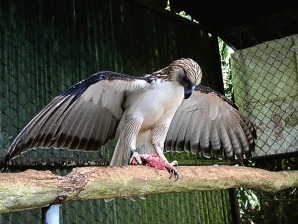Camera captures rare young Philippine Eagle in the wild

The Philippine Eagle’s wing span of 7 feet is world’s broadest. In an INQUIRER file photo, Pag-asa, a Philippine Eagle bred in captivity at a sanctuary in Davao City shows off. Just recently, a “juvenile” Philippine Eagle was recently sighted and photographed at the 3,720-hectare Taft Forest Wildlife (Philippine Eagle) Sanctuary in Taft, Eastern Samar, which is in the Samar Island Natural Park. EDDIE JUNTILLA/PHILIPPINE EAGLE
TACLOBAN CITY—A “juvenile” Philippine Eagle (Pithecphaga jefferyi) was recently sighted and photographed at the 3,720-hectare Taft Forest Wildlife (Philippine Eagle) Sanctuary in Taft, Eastern Samar, which is in the Samar Island Natural Park (SINP).
Ruth Francisco, a Manila-based member of the Wild Bird Club of the Philippines, said she saw and took a picture of a Philippine Eagle on March 10 in the forest of Barangay San Gabriel located about 120 kilometers from Tacloban City.
Francisco, who has been been birding for two years, said she had seen other wild birds in flight and Philippine eagles in captivity, but this was the first time she saw a live Philippine Eagle in the wild.
It was perched on a tree branch about 100 meters from where she was standing, Francisco said.
Her brief encounter with the elusive national bird lasted about five minutes.
“It stayed there until three rufous hornbills flew by and perched in a nearby tree. The noise of the hornbills (seemed to have) disturbed the Philippine Eagle and it flew away,” she said.
According to Francisco, she went to the SINP to look for the Mindanao bleeding heart pigeon that is known to inhabit the area.
With SINP tour guide Joselito Sierra, she went into the forest on the morning of March 10. At 7:55 a.m. she heard sounds from a rufous hornbill.
Expecting the Mindanao bleeding heart pigeon to follow, she got her camera ready. But what came next was a raptor that suddenly perched in a leafless tree. She then realized that it was a Philippine Eagle.
“The presence of the Philippine Eagle is an indicator that we still have an ecologically balanced forest in Samar,” said Manolito D. Ragu, director of the Department of Environment and Natural Resources-Eastern Visayas (DENR-8).
He said there had also been reported sightings of the Philippine Eagle in Leyte.
The Philippine Eagle is endemic to the Philippines and can be found in eastern Luzon, Samar, Leyte and Mindanao.
Following the various sightings of the national bird in Samar, then President Joseph Estrada issued Proclamation No. 155 on July 31, 1999, establishing the 3,720-hectare Taft Forest Wildlife (Philippine Eagle) Sanctuary in the SINP. The park includes Mt. Nahulopan in Taft town.
The first Philippine Eagle was spotted in Samar 117 years ago by John Whitehead, an English explorer and naturalist. On June 13, 1896, Whitehead’s servant, Juan, brought him the first specimen of the “monkey-eating” eagle.
But it was later discovered that the raptor did not just eat monkey but also civets, large snakes, monitor lizards and flying lemur, among others. In 1978, the monkey-eating eagle was renamed the Philippine Eagle.
In 1995, the Philippine Eagle was named the national bird by President Fidel V. Ramos under Proclamation No. 615.














